Mobile and web applications have evolved into something extraordinary. What once required massive development teams and months of complex programming can now be accomplished with a few API calls and smart implementation strategies.
Think about the apps you use every day. Spotify creates personalized playlists that feel like they know your music taste better than you do. Google Photos automatically organizes thousands of images by recognizing faces, objects, and locations.
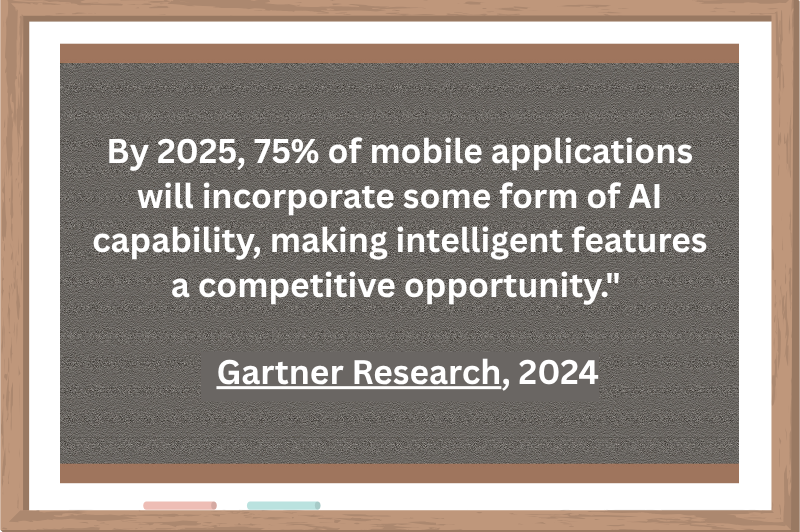
Source: Gartner Research, 2024
This detailed guide provides a practical roadmap for integrating AI into your app, covering everything from initial planning to production deployment.
Key takeaways:
- We’ve guided 100+ companies through successful AI integration, from problem identification to production scaling, avoiding costly mistakes along the way.
- Stop chasing AI hype and start with real problems. We’ve seen too many teams waste months building impressive demos that solve nothing. Focus on user pain points first.
- Data will make or break your project. 80% of failures happen here. Our CRAFT framework (Complete, Representative, Accurate, Fresh, Trustworthy) has saved clients from expensive rebuilds.
- Start smart with APIs, not custom models. Most teams can prove business value in 2-4 weeks for under $1,000/month before committing to six-figure custom development.
- Plan for continuous improvement from launch day. AI models decay without monitoring, but our clients see sustained performance through daily tracking and automated drift detection.
Ready to start building? Jump straight to the implementation steps below
What “AI integration” actually means
AI integration refers to embedding intelligent capabilities into software applications to solve specific problems or enhance user experiences. Rather than building AI systems from scratch, integration focuses on incorporating existing AI technologies, through APIs, SDKs, or pre-trained models, into your application architecture.
Consider it just like adding electricity to your home. You don’t need to build a power plant, you connect to existing electrical infrastructure. Similarly, AI integration connects your app to proven AI services that already understand language, recognize images, or predict user behavior.
Companies have built powerful AI systems that can be accessed through simple code implementations. This approach lets you add features like intelligent chatbots, automatic image tagging, or personalized recommendations in weeks rather than years.
Real-world AI integration examples:
Here are some of the examples that can help you better understand AI integration.
- Chatbots and conversational interfaces
Intercom’s Resolution Bot automatically handles 69% of customer conversations, while Zendesk’s Answer Bot resolves 30% of support tickets with human-like understanding. These systems use Natural Language Processing to understand user queries and provide relevant responses.
- Recommendation systems
Netflix’s algorithm analyzes viewing patterns to drive 80% of content watched on the platform, while Amazon’s recommendation engine generates 35% of total revenue through intelligent product suggestions. These systems use machine learning to predict user preferences with remarkable accuracy.
- Computer vision and image recognition
Pinterest’s visual search lets users find products by photographing items in the real world, while Instagram’s automatic alt-text describes images for visually impaired users. Medical apps like SkinVision analyze photos to detect potential skin conditions with 90% accuracy.
- Personalization and predictive analytics
Duolingo adapts lesson difficulty based on individual learning patterns, increasing completion rates by 25%. Waze predicts traffic conditions and suggests optimal routes by analyzing real-time data from millions of users worldwide.
These applications succeed because companies integrate existing AI capabilities strategically rather than attempting to become AI research labs. The result is more intelligent, responsive, and valuable user experiences.
Now let’s find out in detail how to integrate AI into your app.
Step-by-step: How to integrate AI into your app
We have discussed a detailed roadmap for identifying the right AI problem to solve, choosing technologies and implementation strategies, and deploying it in production with real user testing.
Step 1: Figure out what problem you’re solving
Before discussing AI technologies, I want to start with the most important question: What specific problem will AI solve for your users?
Map your current challenges.
Take a close look at where your app struggles today:
- Where do people get stuck or need help?
- What tasks eat up your team’s time every day?
- What do users keep asking for that you can’t deliver?
- What smart features do successful competitors offer?
Validate your AI idea
Not every problem needs AI. Ask these four questions before moving forward:
Will this actually help users?
AI should solve real problems, not create fancy features nobody wants. Focus on identifying genuine pain points in your user journey where automation or intelligent assistance would provide clear value. Consider whether users are currently struggling with repetitive, time-consuming, or large information-processing tasks.
Do we have what it takes?
Consider your data, team skills, and timeline realistically. Evaluate whether you have sufficient quality data to train effective models and team members with the necessary technical expertise and realistic timeframes for development and testing. Assess your infrastructure capabilities and budget for both initial development and ongoing maintenance.
What’s the business impact?
Calculate potential returns by identifying specific metrics AI could improve. Consider direct revenue increases through better user engagement, cost savings from automated processes, improved customer satisfaction scores, or competitive advantages in your market. Quantify these benefits to justify the investment.
Can we afford to build and maintain this?
Include ongoing costs, not just initial development. Factor in data storage and processing expenses, model training and retraining, infrastructure scaling, team training, and continuous improvement. AI systems require sustained investment to remain effective as data patterns change and user needs evolve.
Step 2: Pick the right AI technology
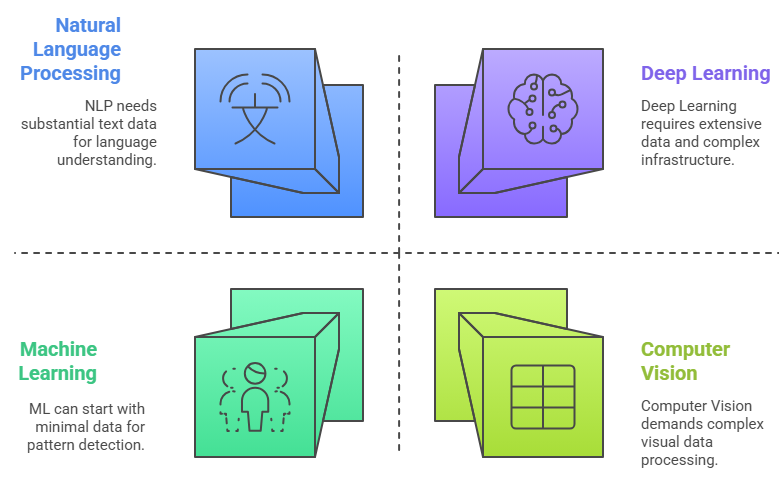
AI technologies are just like different tools in a toolbox. Each one excels at specific tasks, and choosing the wrong one is like trying to hammer a nail with a screwdriver (technically possible), but you’ll waste months in the process.
We’ve seen teams spend six months building complex deep learning systems for problems that could have been solved with simple machine learning in two weeks. Let me save you from that mistake.
1. Machine learning (ML)
Machine learning looks at your historical data and finds patterns that humans might miss. It’s like having a detective who can analyze thousands of cases simultaneously and spot the subtle clues that predict outcomes.
Example
Amazon’s “people who bought this also bought” recommendations
If customers A, B, and C all bought items X and Y, and customer D just bought item X, there’s a high probability that customer D will want item Y. Shopping behavior has predictable patterns based on product relationships, seasonal trends, and customer demographics
What you actually need to get started:
- Minimum viable dataset: 1,000-10,000 records for simple predictions
- Enterprise-grade accuracy: 100,000+ records with consistent formatting
- Data types: Structured data works best (spreadsheets, databases, transaction logs)
- Historical timeframe: At least 6-12 months of data to capture seasonal patterns
Technical implementation reality:
- Timeline: 2-4 months for basic implementation, including data preparation and testing
- Team requirements: One data analyst and one developer can handle most ML projects
- Infrastructure: Modern cloud platforms (AWS, Google Cloud, Azure) provide pre-built ML services
- Ongoing maintenance: Monthly model retraining, quarterly performance reviews
When ML is the wrong choice:
- Your data changes completely every few weeks (fashion trends, viral content)
- You need to understand “why” the AI made each decision (regulated industries often require explainability)
- Your problem involves understanding human language nuances or visual creativity
2. Natural language processing (NLP)
NLP teaches computers to understand, interpret, and generate human language. It’s like giving your application a linguistics PhD who can read, write, and converse in multiple languages simultaneously.
Example
Grammarly’s writing assistance
Grammar rules have thousands of exceptions, context matters enormously, and writing style varies by audience and purpose. Multiple AI models work together. One checks grammar, another analyzes tone, a third suggests vocabulary improvements. Real-time analysis requires processing text as users type, understanding context across entire documents, and providing suggestions without interrupting writing flow.
What you actually need to get started:
- Text volume: 10,000+ examples for basic classification, 100,000+ for advanced understanding
- Data quality: Clean, properly formatted text with consistent labeling
- Language coverage: Representative samples of all language variations your users employ
- Context preservation: Maintain conversation threads and document structure
Common NLP pitfalls teams usually make:
- Underestimating language variety: Users will phrase things in ways you never anticipated
- Ignoring context: The same words mean different things in different situations
- Over-promising accuracy: Even advanced NLP systems make mistakes that humans wouldn’t
3. Computer vision
Computer vision teaches machines to “see” and interpret visual information like humans do, but often with superhuman accuracy and speed. It’s like giving your application eyes that never get tired, never blink, and can process thousands of images simultaneously.
Example
Pinterest’s visual search revolution
Users often can’t describe what they’re looking for in words; they know it when they see it. Using computer vision, multi-layered analysis identifies objects, colors, patterns, styles, and contextual relationships within images. Convolutional Neural Networks extract visual features, similarity algorithms find matching items, and recommendation engines suggest related products
What you actually need to succeed:
- Image quantity: 1,000+ images per category for basic classification, 100,000+ for complex scene understanding
- Label quality: Precise annotations, bounding boxes for object detection, pixel-level masks for segmentation
- Visual diversity: Different lighting conditions, angles, backgrounds, and image qualities
- Real-world representation: Images that match actual usage scenarios, not just clean stock photos
Infrastructure realities:
- Computing power: GPU processing is required for training custom models, and can use CPU for inference with pre-trained models
- Storage requirements: High-resolution images consume significant storage. Plan for 10-100TB for serious computer vision projects
- Processing speed: Real-time applications need <100ms response times, batch processing can take hours for large datasets
4. Deep learning
Deep learning uses neural networks with multiple layers to find incredibly complex patterns in data. It’s like having a brain that can simultaneously consider thousands of factors and their interactions to solve problems that traditional programming can’t handle.
Example
Google Translate’s breakthrough accuracy
Languages have different grammar structures, cultural contexts, idiomatic expressions, and multiple meanings for the same words. Using Deep Learning, transformer neural networks understand entire sentence context, attention mechanisms focus on relevant word relationships, and multilingual training enables zero-shot translation between language pairs. The same model handles 100+ languages, including rare language pairs that have minimal training data
When deep learning can help?
- Unstructured data: Images, audio, video, natural language, sensor data
- Complex pattern recognition: Problems where relationships are too complex for traditional algorithms
- Large datasets: You have millions of examples and the patterns exist but are subtle
- End-to-end learning: You want the AI to learn the entire process rather than hand-coding rules
Deep learning success requirements
- Minimum viable: 100,000 examples for simple classification
- Production quality: 1,000,000+ examples for complex tasks like language understanding
- Continuous improvement: Plan for ongoing data collection, even Google and Facebook continuously gather training data
Infrastructure investment:
- Training costs: $10,000-$100,000+ for cloud GPU time, depending on model complexity
- Development team: PhD-level AI expertise typically required, 6-18 month development timelines
- Ongoing costs: Model serving, continuous training, infrastructure maintenance
Technical complexity:
- Hyperparameter tuning: Thousands of configuration options affect performance
- Training instability: Models can fail to converge or produce inconsistent results
- Debugging difficulty: Understanding why deep learning models make specific decisions is extremely challenging
Making the right choice for your situation:
The key is an honest assessment of your requirements, resources, and constraints. Too many teams choose deep learning because it sounds impressive, and then struggle with the complexity they don’t need. Start with the simplest approach that could work, prove the business value, and then upgrade to more sophisticated techniques if needed.
Step 3: Decide how to build it
You have three main paths. Choose based on your timeline, budget, and team expertise.
Option 1: Use ready-made AI APIs (recommended for most apps)
In this option, you can get powerful AI features working in weeks, not months
Popular choices:
- OpenAI GPT-4: For chatbots, content generation, and text analysis
- Google Vision API: For image recognition and document scanning
- AWS Comprehend: For sentiment analysis and text insights
- Azure Speech Services: For voice recognition and text-to-speech
Option 2: Build custom AI models
This option works well when you want to create unique capabilities that competitors can’t easily copy
When it makes sense:
- You have proprietary data that gives you an advantage
- Your use case is highly specialized
- You need complete control over the AI behavior
Option 3: Partner with AI development experts
With this option, you can get custom AI solutions without building an internal data science team
It’s Complex requirements with tight timelines. At Folio3, we help companies integrate AI solutions across healthcare, finance, and e-commerce, delivering working systems tailored specifically according to your guidelines.
Step 4: Master your data strategy
Here’s something most AI guides won’t tell you upfront: data preparation typically takes 80% of your AI project time. We’ve seen brilliant teams with cutting-edge algorithms fail because they underestimated this step. Let’s make sure that doesn’t happen to you.
Before we move into collection strategies, let’s clarify what makes data useful for AI. It’s not just about having lots of information; it’s about having the right information in the right format.
Three types of AI learning
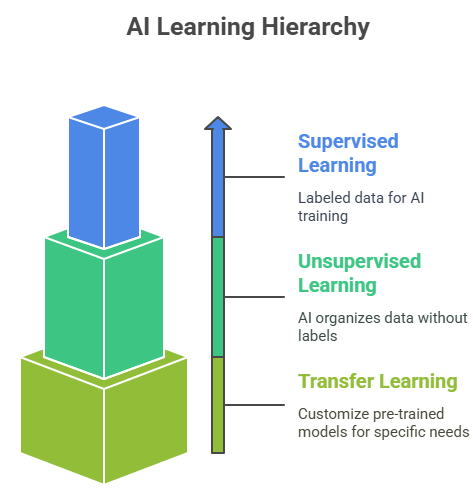
Let’s explore each step by step.
Supervised learning
Think of this like teaching a child to recognize animals by showing them pictures with labels. Your AI needs to see thousands of examples where you’ve already provided the “correct answer.”
What you need:
- Minimum dataset size: 1,000-10,000 labeled examples for simple tasks
- Complex tasks: 100,000+ examples (image recognition, natural language)
- Quality over quantity: 1,000 perfectly labeled examples beat 10,000 messy ones
Unsupervised learning
This is like giving your AI a box of mixed-up photos and asking it to organize them into groups without telling it what to look for.
What you need:
- Volume matters: Millions of data points work better than thousands
- Clean formatting: Inconsistent data formats will confuse pattern detection
- Representative sampling: Data should cover all scenarios your AI will encounter
Transfer learning:
This lets you use AI models that tech giants have already trained on massive datasets, then customize them for your specific needs.
What you need:
- Much smaller datasets: Often just 100-1,000 examples
- High-quality examples: Since you’re working with less data, each example matters more
- Domain-specific data: Your examples should closely match your actual use case
The data quality framework that actually works
We have learned this framework from a data scientist who spent five years at Google. It’s saved countless projects from expensive mistakes. Data preparation consumes 80% of AI project time. The CRAFT framework ensures your data foundation won’t sabotage months of development work.
CRAFT framework table
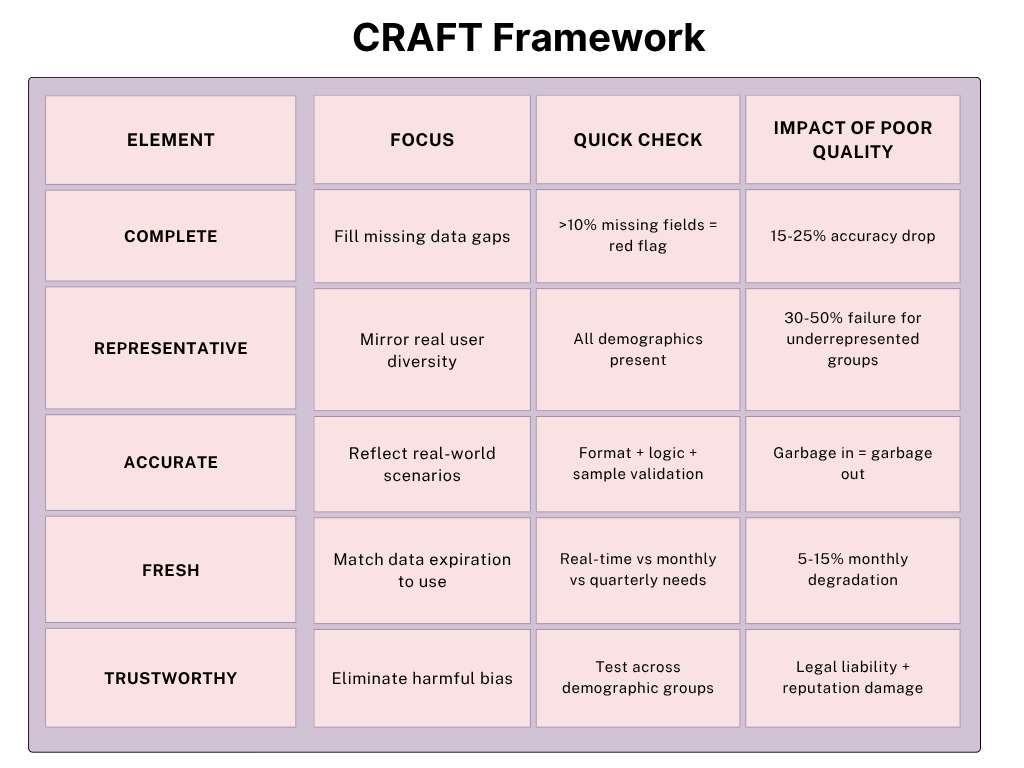
Overview of CRAFT Framework
Complete: Fills missing data gaps that break AI predictions. Prevents model failures when users don’t provide optional information or data collection systems have gaps.
Representative: Ensures AI works for all users, not just dominant groups. Prevents algorithm performance drops for minorities, different regions, or varying usage patterns.
Accurate: Validates data reflects real-world scenarios through format checks, logical consistency rules, and sample verification. Eliminates garbage data that produces unreliable AI outputs.
Fresh: It matches data update frequency to how quickly information becomes outdated, preventing AI from making decisions based on stale user preferences or market conditions.
Trustworthy: Eliminates bias that creates unfair AI decisions. Ensures AI performs equally well across demographic groups and prevents legal liability from discriminatory algorithms.
Critical success factors
Poor data quality is the #1 reason AI projects fail in production. Microsoft’s Tay chatbot disaster happened because they didn’t filter training data for bias. Start with data audits before building models. Fix quality issues early as it’s 10x more expensive to correct biased AI after deployment than during development.
Advanced data collection strategies
Now that we’ve covered the basics, let’s talk about sophisticated data collection approaches that can give you a real competitive edge.
Strategy 1: The progressive data web
Instead of trying to collect all your data upfront, build systems that naturally gather better data over time.
Implementation approach:
- Collect essential user information during onboarding to establish baseline profiles and immediate personalization needs
- Track user interaction patterns, feature usage, and struggle points during normal app operation to identify optimization opportunities
- Infer user preferences from engagement metrics, time spent, and completion rates rather than relying on explicit surveys
- Measure user success rates, learning curves, and achievement patterns over extended periods to understand long-term value delivery
- Capture community interactions, sharing behaviors, and competitive dynamics through social features to understand network effects
Strategy 2: Smart synthetic data generation
Sometimes, the data you need doesn’t exist yet. In such a situation, creating high-quality synthetic data can jumpstart your AI development.
When synthetic data makes sense:
- Privacy-sensitive applications: Healthcare, finance, personal data
- Rare scenarios: Edge cases that happen infrequently but matter
- Balanced datasets: Ensuring equal representation across groups
- Testing environments: Safe spaces to test AI behavior
Strategy 3: Collaborative data networks
Sometimes the best way to get better data is to work with others who have complementary datasets.
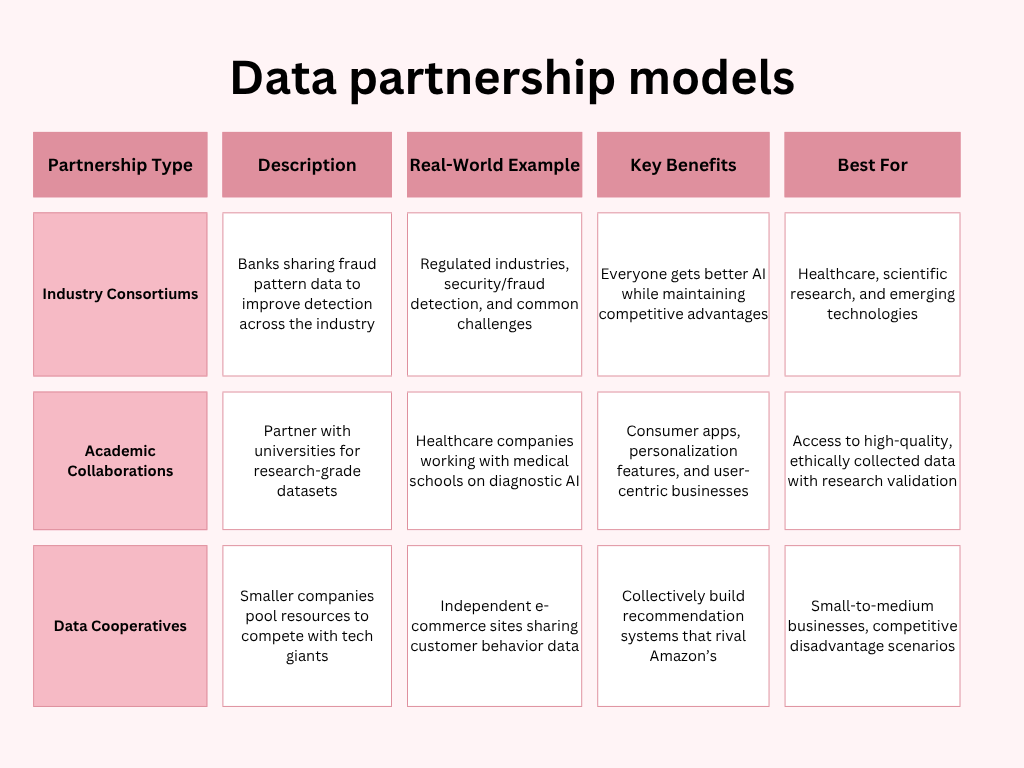
Data annotation: the art and science of teaching AI
Getting your data labeled correctly is often the difference between AI that works and AI that embarrasses you in production.
Understanding annotation complexity
Simple annotations:
It’s an annotation that anyone can do with basic training.
- Image classification: “Does this photo contain a cat?”
- Sentiment analysis: “Is this review positive, negative, or neutral?”
- Content categorization: “Which product category does this item belong to?”
Medium complexity annotations:
This type of annotation requires domain knowledge.
- Medical image analysis: “Identify potential abnormalities in this X-ray.”
- Legal document analysis: “Extract key terms and conditions from this contract.”
- Financial analysis: “Categorize this transaction by risk level.”
Expert-level annotations:
Specialists are required to do this type of annotation.
- Clinical diagnosis: “What condition does this patient likely have?”
- Legal precedent analysis: “How does this case relate to established law?”
- Scientific research: “What compounds are present in this chemical analysis?”
Advanced data testing and validation
Before you feed data into your AI system, you need to be absolutely certain it will work in production scenarios.
The data testing pipeline
Here are a few things you should take care of while finalizing your data.
Step 1: Does your data look normal?
Compare your training data to real production data
Tools: Simple statistical tests, charts, outlier detection
Red Flag: Training data is very different from real user data
Step 2: Does your data make sense?
Have business experts review the data
Issue: Patterns that don’t match reality (like winter coat sales in summer)
Step 3: Will AI learn the right things?
Make sure AI focuses on relevant features, not irrelevant ones
Red Flag: AI thinks “user ID” or “timestamp” are the most important factors
Stop training if:
- Your training data looks completely different from production
- Business experts say data doesn’t make sense
- AI focuses on irrelevant features like timestamps or IDs
Setting up data infrastructure for scale
As your AI system grows, your data needs will evolve. Building a scalable data infrastructure from the start can save you massive headaches later.
The modern data stack
A modern data stack uses cloud-native tools to collect, store, process, and govern data efficiently, laying the foundation for scalable, AI-ready infrastructure from day one.
Data collection layer
- Event tracking: Capture user interactions in real-time
- API integration: Pull data from external sources systematically
- IoT sensors: Collect environmental or device data if relevant
- User feedback: Built-in mechanisms for users to correct AI mistakes
Data storage layer
- Store everything in its original format
- Clean, structured data ready for AI
- Pre-computed features available for multiple AI models
- Versioned storage for trained AI models
Data processing layer
- Extract, Transform, Load processes for data preparation
- Process data as it arrives for immediate AI responses
- Handle large-scale data transformations efficiently
- Automated checks for data consistency and completeness
Data governance layer
- Who can see and modify what data
- GDPR, CCPA, and other regulatory requirements
- Complete history of data changes and access
- Track where each piece of data came from and how it was transformed
Step 5: Implementation that works
Turning AI plans into real, working solutions requires a practical, user-focused approach. Start simple, build for scale, and test rigorously to ensure your AI performs reliably in the real world.
Build with growth in mind.
- Design your system to handle increased usage without breaking
- Plan for when AI gives unexpected results
- Create ways for users to correct AI mistakes
- Track accuracy and response times from day one
Security measures for AI integration
AI systems handle sensitive information and require robust security measures from day one.
Essential security steps: Here are some crucial security steps you should take to protect your data.
Data protection:
- Use HTTPS for API calls and encrypt data storage
- Only gather information you actually need for AI functionality
- Remove personal identifiers from training and processing data
- Ensure data travels safely between your app and AI services
Access control:
- Rotate API keys regularly and never expose them in client-side code
- Implement proper login systems before users access AI features
- Limit AI feature access based on user roles and needs
- Prevent abuse by limiting AI requests per user/session
Input validation:
- Clean and validate all data before sending to AI systems
- Block malicious prompts and harmful input patterns
- Screen for inappropriate or dangerous content requests
- Restrict input length and file sizes to prevent system overload
Monitoring and compliance:
- Track all AI interactions for security monitoring and debugging
- Follow GDPR, CCPA, and relevant data protection regulations
- Audit AI system access and permissions monthly
- Prepare procedures for handling security breaches or AI misuse
Red flags to watch:
- Unusual API usage patterns that might indicate attacks
- AI responses that seem inappropriate or biased
- Unexpected data access requests or permission escalations
- Performance degradation that could signal security issues
60% of AI security breaches happen due to poor implementation, not sophisticated attacks. Basic security measures prevent most problems.
3. Common challenges, real costs, and proven best practices
Now that you have understood how to integrate AI into your app, it’s time to address its challenges. AI integration isn’t just a technical challenge; it’s a business transformation. Many teams face hidden hurdles, rising costs, and unclear ROI. Here’s how to avoid common pitfalls and implement what works.
Common challenges with AI integration:
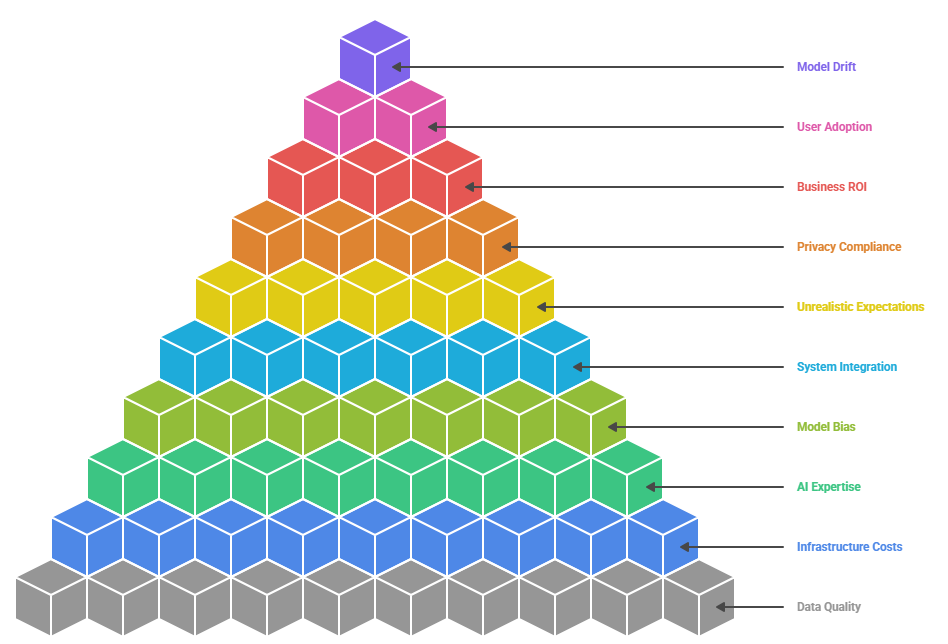
Most AI projects fail not because of bad technology, but because teams underestimate these common challenges. Here’s what actually goes wrong and how to fix it:
1. Poor data quality
Customer records often contain missing fields, inconsistent formats, and test data. AI models trained on messy inputs produce unreliable outputs.
2. Exploding infrastructure costs
Initial cloud usage starts small but can rapidly scale to unsustainable monthly costs, raising concerns about long-term return on investment.
3. Lack of AI expertise
Many development teams struggle with machine learning concepts. Hiring specialized AI talent is expensive and hard to retain.
4. Model bias and accuracy issues
AI systems may work well in test environments but fail in production. Biases in training data can lead to unfair or inaccurate outcomes.
5. Legacy system integration nightmares
New AI tools must often connect with outdated databases and internal systems, which weren’t designed to support modern technologies.
6. Unrealistic expectations
Stakeholders sometimes demand near-perfect accuracy and instant results, without accounting for the time needed to improve AI systems iteratively.
7. Data privacy and compliance complexity
Regulations like GDPR and HIPAA introduce strict requirements. A single misstep can lead to large fines and damaged trust.
8. Unclear business ROI
Projects often prioritize technical performance metrics rather than focusing on measurable business outcomes like revenue growth or operational savings.
9. User adoption resistance
End users may distrust AI or feel threatened by automation, leading to low engagement and underuse of AI features.
10. Maintenance and model drift
AI models degrade over time as data patterns shift. Without ongoing monitoring and updates, performance steadily declines.
Solutions That Work

Now that we have understood the problems, let’s find out how you can solve them.
1. Implement the CRAFT data quality framework
Apply a structured approach to improve data inputs. Fill gaps, validate accuracy with business logic, automate data freshness, ensure diversity in sources, and audit regularly for bias.
2. Start with APIs
Before building custom infrastructure, begin with third-party AI services ($100-$1000/month). Use caching to reduce API calls by 60%, implement serverless computing for variable workloads, and set budget alerts to prevent cost surprises.
3. Build AI capability gradually
Cross-train existing developers with AI fundamentals instead of hiring expensive specialists. Partner with AI consultants who transfer knowledge to your team. Use no-code AI platforms for business analysts to create simple models.
4. Create bias detection systems
Test AI performance across different demographic groups. Implement confidence scoring that flags uncertain decisions for human review. Build user feedback loops so people can correct AI mistakes and improve the system.
5. Use API gateway architecture
Create a translation layer between legacy systems and modern AI services. Gradually modernize components using microservices. Build new data pipelines alongside existing systems without disrupting operations.
6. Set realistic success metrics
Focus on business impact over technical perfection. Start with 80% accuracy that solves real problems rather than 95%, which takes six months longer. Demonstrate incremental value through quick wins and iterative improvements.
7. Implement privacy-by-design
Build data protection into AI systems from the start. Use encryption everywhere, minimize data collection, and provide clear user consent mechanisms. Create audit trails for regulatory compliance and data usage transparency.
8. Establish clear ROI measurement
Track cost savings (reduced manual work), revenue growth (increased conversions), and efficiency gains (faster processes). Use A/B testing to prove AI impact. Calculate customer lifetime value improvements and operational cost reductions.
9. Design for user trust and control
Provide explanations for AI decisions (“recommended because you liked similar items”). Allow users to override AI suggestions. Show confidence levels with predictions. Create feedback mechanisms so users feel like partners, not subjects.
10. Build continuous improvement systems
Monitor AI performance daily, not monthly. Implement automated data drift detection. Use A/B testing for model improvements. Create version control for AI models with instant rollback capabilities if problems occur.
Need help implementing these solutions?
Our expert AI development team at Folio3 has guided 100+ companies through successful AI integration, avoiding common pitfalls and accelerating time-to-value.
You can check out our use cases here.
4. How much does it cost to integrate AI into an app
Let’s talk numbers. Too many companies are shocked by AI costs because they don’t understand what they are really buying. Here’s the honest breakdown based on actual projects.
Simple integration: $10,000 – $50,000
What you actually get:
- Pre-built API integration (chatbot for FAQ, image recognition for uploads)
- Basic user interface that connects to AI services
- Simple error handling and response formatting
- Basic analytics and usage tracking
Moderate complexity: $50,000 – $200,000
What you actually get:
- Custom model training for your specific use case
- Advanced user interfaces with personalization
- Integration with existing business systems
- Performance optimization and caching
- Security and compliance implementation
Complex implementation: $200,000 – $500,000+
What you actually get:
- Multiple AI capabilities working together
- Enterprise-grade security and compliance frameworks
- Custom infrastructure optimized for your use case
- Advanced monitoring and automated retraining
- Full integration with enterprise systems
Custom AI vs third-party tools
Now let’s talk about the cost of a third-party API and developing it on your own.
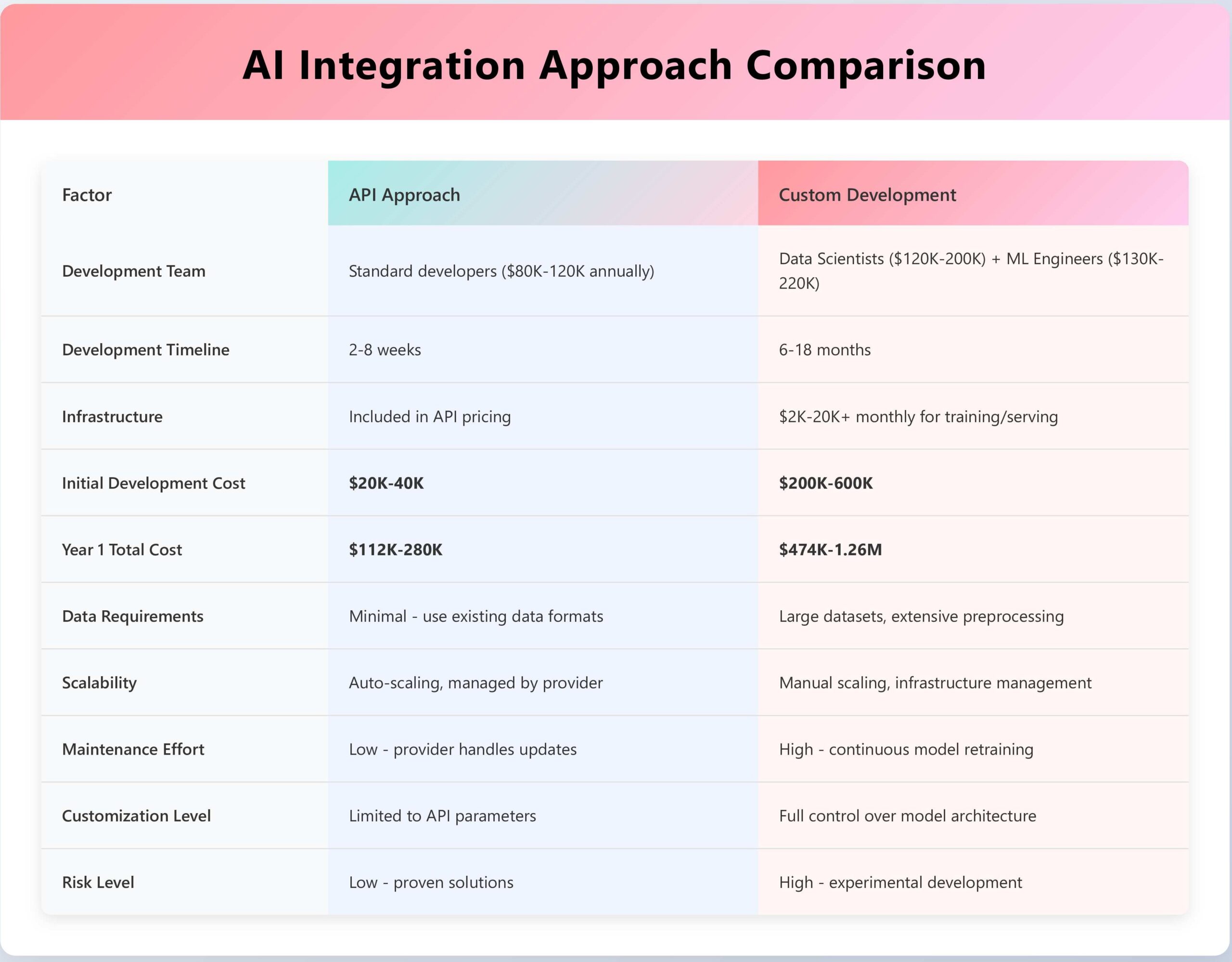
5. How to integrate AI into your app – best practices
After watching hundreds of AI implementations, we’ve learned that technical excellence isn’t enough. The most successful AI projects follow specific patterns that maximize business value while minimizing risk.
Start small with one AI feature
Choose a specific use case that directly solves a real user pain point and has measurable business impact. For example, instead of building a comprehensive AI assistant, focus solely on automating your most common customer support questions that currently waste 2 hours of staff time daily. Implement just the basic functionality, handle 5-10 frequent questions with simple, accurate responses rather than trying to solve every possible customer inquiry.
Focus on business ROI, not hype
Track three core areas of return on investment: cost savings from reduced manual work (like cutting support ticket response time from 2 hours to 5 minutes), revenue growth through improved user experience (higher conversion rates when customers get instant, accurate answers), and efficiency gains from faster, more accurate processes that free up your team for strategic work.
Your key performance indicators should directly connect AI performance to business outcomes. Monitor user engagement metrics, such as how long people stay on your app after interacting with AI features, operational metrics, such as response accuracy and error rates, and critical business impact measurements, including revenue per user and customer retention rates.
Make models explainable & ethical
Implement explainable AI features that build user trust by showing confidence scores with each prediction, explaining decision reasoning in plain language, highlighting which data points influenced the decision, and presenting alternative options when appropriate.
Establish ethical AI guidelines through regular bias detection audits that test for discriminatory outcomes across different user demographics. Implement fairness metrics to ensure equal treatment regardless of age, gender, or background. Also, maintain transparency by clearly communicating how AI is used and its limitations, and always provide user control options to opt out or override AI decisions when they disagree with recommendations.
Ensure privacy, security, and compliance
Data privacy protection should be prioritized through data minimization (collecting only essential information), robust encryption for data in transit and at rest, anonymization techniques that remove personally identifiable information, and clear user consent processes for AI feature usage.
Implement comprehensive security best practices, including proper API authentication and rate limiting, input validation to prevent malicious attacks and prompt injection, strict access controls limiting AI system access to authorized users only, and detailed audit logging that tracks all AI interactions for security monitoring.
Adhere to GDPR requirements for explanation rights and data portability, CCPA standards for privacy transparency, HIPAA regulations for healthcare AI applications, and industry standards like SOC 2 and ISO 27001 for enterprise deployments to ensure regulatory compliance.
Regular model updates post-launch
Establish a continuous improvement process that includes daily performance monitoring of accuracy and user satisfaction metrics, data drift detection systems that identify when model performance degrades due to changing user behavior or market conditions, systematic feedback integration that incorporates user corrections and ratings into model improvements, and scheduled retraining with fresh data to maintain relevance.
Manage updates through rigorous A/B testing that compares new models against existing ones before full deployment, gradual rollout strategies that deploy updates to small user groups first to catch issues early, robust rollback capabilities for quick reversion.
6. Why choose Folio3 for AI app integration
Folio3 accelerates your AI journey with proven expertise, pre-built solutions, and end-to-end support from strategy to scaling across all industries.
Proven track record in AI app development
We’ve successfully delivered 100+ AI projects across healthcare, finance, retail, and SaaS industries, serving 50+ clients from startups to Fortune 500 companies. Our 5+ years of deep expertise in machine learning and AI integration ensures you avoid common pitfalls and accelerate time-to-market with battle-tested solutions.
Full-stack AI expertise
We deliver custom ChatGPT integrations for customer support, content generation systems for marketing and documentation, and code assistance tools for development teams.
Computer Vision Solutions: Our computer vision expertise spans medical imaging analysis for healthcare applications, quality control systems for manufacturing, and facial recognition with biometric authentication.
Natural Language Processing: We build sentiment analysis systems for social media monitoring, document processing and information extraction tools, and multi-language chatbots with virtual assistants.
Machine Learning Platforms: Our ML expertise includes recommendation engines for e-commerce that drive 35%+ revenue increases, predictive analytics for business intelligence, and fraud detection systems for financial services.
Prebuilt models, frameworks, and accelerators
Our rapid prototyping approach delivers MVP solutions in 2-4 weeks using industry-specific pre-trained models ready for customization. We also build cloud-native architectures on AWS, Azure, and Google Cloud with security-first design and built-in compliance for GDPR, HIPAA, and SOC 2 requirements.
Support from ideation to post-launch scaling
We provide complete AI journey support, starting with strategy and planning, through AI readiness assessment and roadmap development, followed by design and development, including user experience design and technical implementation.
Frequently asked questions
Q: How long does it typically take to integrate AI into an existing app?
A: Simple AI integrations (chatbots, basic recommendations) typically take 2-4 weeks. More complex implementations with custom models and enterprise integration take 3-6 months. We provide detailed timelines during our initial assessment.
Q: What’s the difference between using AI APIs versus building custom models?
A: AI APIs offer faster implementation and lower upfront costs ($100-$1000/month) but have ongoing usage fees. Custom models require higher initial investment ($50K-$500K) but provide unique competitive advantages and lower long-term costs for high-volume applications.
Q: How do you ensure AI models remain accurate over time?
A: We implement continuous monitoring systems that track performance metrics daily, detect data drift automatically, and trigger retraining when needed. Our A/B testing frameworks ensure model updates improve performance before full deployment.
Q: Can you help with AI compliance for regulated industries?
A: Yes, we specialize in healthcare (HIPAA), financial services (SOX/PCI), and other regulated industries. Our team understands industry-specific requirements and builds compliance frameworks into AI systems from the ground up.
Q: What happens if our AI system fails or produces incorrect results?
A: We build multiple safety nets including confidence scoring, human-in-the-loop review for uncertain decisions, instant rollback capabilities, and 24/7 monitoring with immediate alerts. Our incident response procedures ensure rapid problem resolution.
Q: Do you provide training for our internal team to manage AI systems?
A: Absolutely. We offer comprehensive training programs covering AI system management, performance optimization, and basic troubleshooting. Our knowledge transfer approach ensures your team can independently maintain and improve AI systems.
Q: How do you handle data privacy and security?
A: We implement privacy-by-design principles with end-to-end encryption, data minimization, user consent management, and comprehensive audit logging. All solutions comply with GDPR, CCPA, and industry-specific privacy requirements.
Final words
AI integration has moved from competitive advantage to business necessity. Companies implementing AI features report considerable improvements in user engagement and substantial reductions in operational costs. The key to success lies in strategic implementation: start with clear business objectives, choose the right technology approach, and focus on user value over technical complexity.
Ready to transform your application with AI? The opportunity is now, and the tools are available. Take the first step toward building smarter, more engaging applications that truly understand and help your users.

Laraib Malik is a passionate content writer specializing in AI, machine learning, and technology sectors. She creates authoritative, entity-based content for various websites, helping businesses develop E-E-A-T compliant materials with AEO and GEO optimization that meet industry standards and achieve maximum visibility across traditional and AI-powered search platforms.









